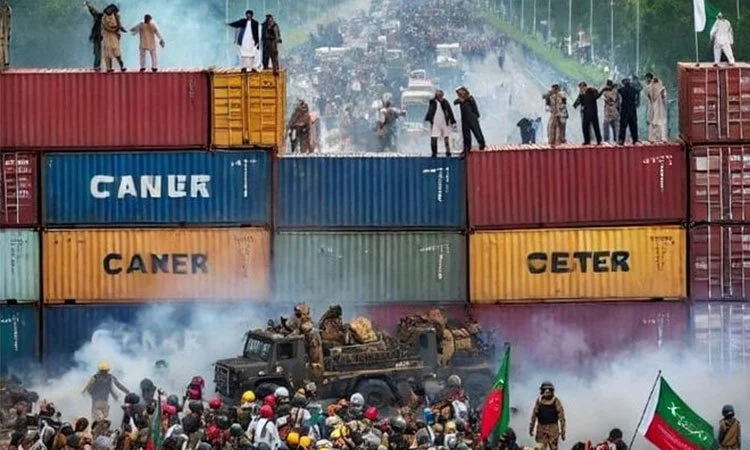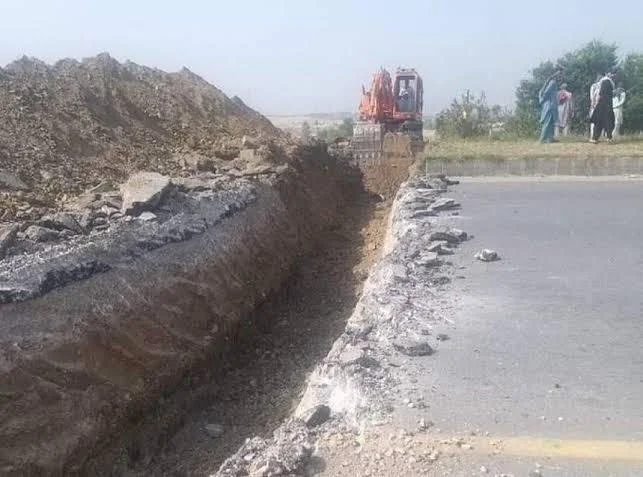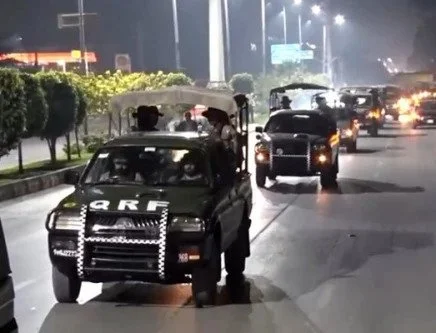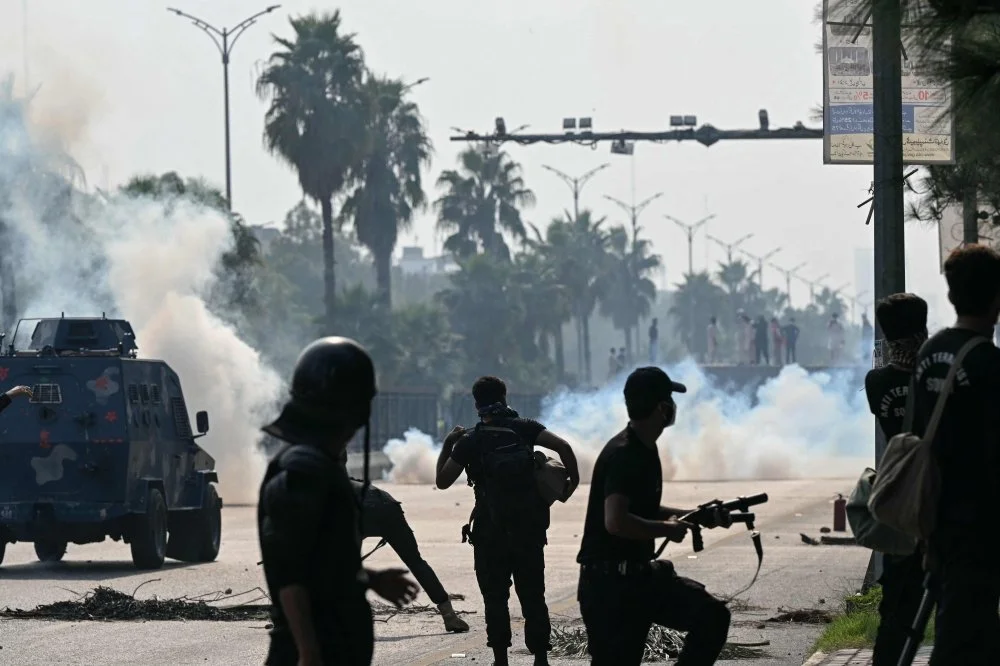PTI’s capital protest: How things got to where they are today
The party’s leaders and workers seize parts of Red Zone
A massive blockade erected to stop protesters from reaching Islamabad's Red Zone
THE federal capital seemed to have become paralysed on Friday (Oct 4) after thousands of workers and supporters of Pakistan Tehreek-e-Insaf (PTI) marched on the city as per the directives of their jailed chairman Imran Khan. Educational institutions, businesses, and communications and mass transit services came to a standstill in the twin cities in anticipation of the PTI’s “peaceful protest”.
The big demonstration was largely in response to the continued imprisonment of PTI founder Imran Khan and his party's ongoing grievances regarding judicial independence and perceived governmental overreach. The protest was marked by significant tensions and clashes with law enforcement personnel.
PTI lawyers protesting outside the building of Supreme Court of Pakistan against the proposed constitutional amendments and the continued imprisonment of Imran Khan
In the days leading up to the protest, the government had repeatedly urged PTI to postpone the protest because of the presence of foreign dignitaries in the capital and in view of the SCO summit scheduled to be held in Islamabad on Oct 15-16. Additionally, on Oct 2, Malaysian Prime Minister Anwar Ibrahim arrived in Pakistan for a three-day official visit.
Mr Khan and company used social media outlets to rally support for the demonstration, urging citizens to participate in a “peaceful protest” against what he termed “the illegal detention of political leaders and the government’s failure to uphold constitutional rights”. He characterised the current period as a pivotal one in the struggle for “true freedom for Pakistanis”.
Despite warnings from the authorities about possibility of widespread unrest, PTI leaders remained resolute in their plans.
Attempts to derail the protest
Leading up to the demonstration, the government implemented their plans to stop the protesters from reaching the capital. This included measures like closure of all routes leading into Islamabad and the severing of road links between the twin cities to restrict people’s movement.
Over 600 shipping containers were deployed on 27 thoroughfares and intersections in the capital, such as Murree Road, Faizabad, Peshawar Morr and Zero Point. Key points in neighbouring Rawalpindi, like Charing Cross, M.H. Chowk, Mall Road, Flashman Road, and Marir Chowk, were also blocked.
The containers were welded together in several areas to fortify the blockades. The police also detained over 100 PTI members, including sisters of PTI supremo, Express Tribune reported.
Furthermore, the authorities dug trenches and placed iron nails (to burst vehicles’ tyres) on a one-kilometre-long stretch of the Islamabad-Peshawar Motorway, near the Hazro interchange, according to daily Dawn.
The trench that was dug across the Islamabad-Peshawar Motorway to halt PTI protesters' advance
One of the nails placed on the highway, ostensibly to damage tyres of the PTI activists' vehicles
Containers were also placed at key points along the Rawalpindi-Peshawar section of the G.T. Road — including the Attock Khurd Bridge, Wah Garden Bridge and Haro Bridge near Hasanabdal, the newspaper reported.
Interior Minister Mohsin Naqvi visited D-Chowk, Islamabad, with the capital police chief to inspect the arrangements made to halt the protesters’ advance. On the occasion, Mr Naqvi stated: “We have made arrangements for the security of our foreign guests; apologies for the inconvenience to the citizens of Islamabad. Protesters should take hold of their senses. Visitors should feel they are visiting a safe country,” according to the state-owned PTV.
Mr Naqvi instructed security personnel to maintain law and order at all costs.
Interior Minister and PCB Chairman Mohsin Naqvi
Units of Pakistan Army took over security duties in Islamabad under Article 245 of the Constitution, following directives from the Ministry of Interior, Express Tribune said.
Army units moving into position to control the protesters
Clashes between protesters and security personnel
A convoy consisting of thousands of PTI workers and supporters led by Khyber Pakhtunkhwa (KP) Chief Minister Ali Amin Gandapur left Peshawar on Friday, setting their sights on Islamabad. Besides supporters, his convoy included more than 40 Rescue vehicles. Ambulances, fire tenders and heavy machines (excavators, cranes, etc.) were also in the convoy. About 120 rescue personnel were there too.
Mr Gandapur’s convoy began its journey in Peshawar, with the PTI workers from adjacent districts gathering at the Islamabad-Peshawar Motorway interchange. The convoy’s size increased as waves of protesters from other regions joined it at key points along the motorway.
An aerial view of the PTI's convoy which 'invaded' Islamabad on Friday
Mr Gandapur told the protesters: “We will reach D-Chowk (in Islamabad) even if it takes days to do so.” He went on to say the PTI workers would reach and occupy D-Chowk until they receive further directives from Mr Khan.
In districts neighbouring Islamabad such as Jhelum, roads remained blocked with shipping containers, severing access to the capital. Police raids in Gujjar Khan, Jhelum, and other towns yielded minimal results, with only a few activists arrested over two days.
At the Burhan Interchange, located on the Peshawar-Islamabad Motorway, clashes broke out between Mr Gandapur’s activists and police. Tear gas was fired to control the protesters as police sought to bring them under control. Additionally, several PTI workers were arrested as they attempted to continue their march on the capital.
In a dramatic development, about 9,000 marchers stranded in the Burhan rest area, which had been barricaded with the help of a large number of containers, managed to remove 25 of them from their path to continue their onward journey.
As some PTI workers and supporters reached D-Chowk in Islamabad’s Red Zone, police resorted to tear-gas shelling in an effort to disperse them. A clash broke out at D-Chowk as law enforcement personnel continued to fire tear gas at the protesters. Police claimed they had detained over 30 people in the crackdown.
As the clash intensified, some of the activists “fired” glass marbles at the police personnel using slingshots.
In the meantime, videos surfaced of protesters cutting cakes at D-Chowk as the clock struck 12 (midnight), for commemorating their incarcerated leader’s 72nd birthday. The Islamabad Police later deployed two armoured personnel carriers to control the situation.
Protesters cutting a cake to celebrate Imran Khan's birthday at Islamabad's D-Chowk
The PTI workers clashed with police on Jinnah Avenue in Islamabad and security personnel used tear gas to disperse them. But despite the authorities’ efforts, small groups of demonstrators managed to breach the barriers on Saturday morning.
Security forces using tear gas in an attempt to stop the protesters' progress
As the day wore on, the size of the gatherings grew, with 300 to 400 protesters reaching China Chowk on Jinnah Avenue by the afternoon and removing containers to advance further into the city.








